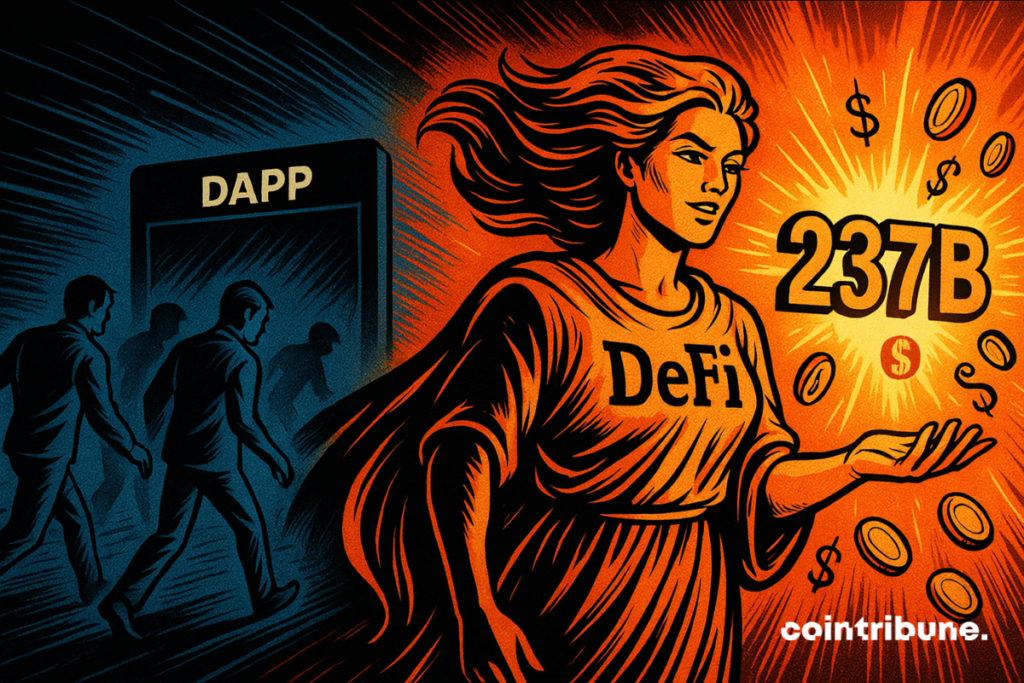DApps lose 22% of users, but DeFi attracts capital
The crypto market is going through a strange season. Activity is slowing on the user side, but financial flows are intensifying behind the scenes. Amid a storm of innovation, some dApps are losing their audience, while DeFi is consolidating its foundations. Fewer clicks, but more capital. A two-speed dynamic is setting in, reshaping the balances within an ever-moving ecosystem.

In brief
- DApps are losing attendance, with a massive drop in active wallets in the third quarter.
- The SocialFi segment collapses, while gaming struggles to maintain its natural attractiveness.
- DeFi records a historic capital record, driven by stablecoins and regulation.
- NFTs become financial assets, integrating into DeFi mechanics with new protocols.
The silent erosion of active dApp users
The mood is gloomy on the side of dApp. The industry recorded a general decline in attendance. Pillars like the SocialFi or AI categories saw their numbers melt away. Even experiences that seemed built to last are losing ground.
Virtuals Protocol, fueled by the rise of AI agents, now attracts only 1,000 to 1,500 wallets per day, compared to 10,000 on average the previous quarter. As for social dApps like Layer3 or The Arena, they struggle to hold attention.
The DApps industry recorded a 22.4% drop in the number of unique daily active wallets. In the third quarter of 2025, it attracted an average of 18.7 million wallets per day.
DappRadar Q3 2025 Report
Even the gaming segment, dominant with 25% market share, struggles to renew itself. Between daily logins and game rewards, engagement seems more artificial than real. The formula stagnates, and so does the enthusiasm.
This slowdown raises questions. The crypto sector lacks neither projects nor announcements. But for the average user, the perceived value seems unclear. Technological innovation is no longer enough if it is not accompanied by clear, simple, and attractive usage.
DeFi: decentralized finance is gaining ground
While mainstream dApps are running out of steam, DeFi is attracting major accounts. Total Value Locked (TVL) has crossed a historic peak, driven by several converging dynamics.
Stablecoins, first, establish themselves as a bridge between traditional finance and crypto. Their inflows approach $46 billion, dominated by Tether (USDT) and USD Coin (USDC). Next, regulation plays a catalyst role. In the United States, the GENIUS Act laid the legal groundwork for stablecoins, reassuring investors and institutions.
Plasma, a new blockchain dedicated to stablecoins, captured more than $8 billion TVL from launch. Added to this are investments through Bitcoin ETFs or crypto allocation funds, which strengthen confidence in the DeFi ecosystem.
As DappRadar summarizes:
NFTs are no longer just simple images of apes: they now merge with the emerging trend of real-world assets (RWA) and DeFi.
Translation: boundaries are blurring between digital finance, real assets, and structured products.
DeFi’s success is rooted in the robustness of its infrastructure. Even when some projects are questioned – like Aster on BNB Chain – the trend remains bullish. Lending protocols, cross liquidity, and the arrival of institutional capital reinforce a DeFi that appeals to fund managers much more than casual gamers.
DApps, NFT, DeFi: changing uses in the crypto universe
Beyond the numbers, a deeper movement is emerging. The crypto industry is entering a phase of specialization. NFTs, once seen as visual gadgets, are becoming full-fledged financial instruments.

Let’s take Courtyard, a platform that allows tokenization of physical collectible cards (Pokémon, baseball, etc.). Each NFT corresponds to a tangible object, stored, exchangeable and even physically deliverable. Result: 1.55 million units sold for a volume of $145 million in Q3.
Another innovation: PunkStrategy, a decentralized protocol that automates the buying and reselling of CryptoPunks. Users bet on $PNKSTR tokens, which finance the purchase of a punk. On resale, the profits burn tokens, reducing their supply. It’s pure DeFi mechanics.
Even platforms like OpenSea have revived interest via airdrop campaigns. This leads to an explosion of micro-transactions on low-value NFTs. Behind the folklore hides a logic of financial optimization.
Key points of this crypto quarter
- The sports NFT sector explodes with a +337% increase, driven by Sorare;
- More than 18.1 million NFTs sold, but mainly to already active users;
- Plasma, a chain dedicated to stablecoins, reaches $8 billion TVL in its first month;
- Stablecoins inject $46 billion into DeFi;
- Virtuals Protocol loses 90% of its audience in three months.
The playground is evolving. Crypto is no longer limited to running digital communities. It is organizing, structuring, becoming quieter… but infinitely more powerful.
A recent sector analysis reveals that the rise of DeFi rests on three well-identified pillars: decentralized lending, tokenization of real assets, and the rising power of stablecoins. Three silent driving forces that are reshaping the contours of a more open, less centralized finance, and more connected to the tangible economy.
Maximize your Cointribune experience with our "Read to Earn" program! For every article you read, earn points and access exclusive rewards. Sign up now and start earning benefits.
La révolution blockchain et crypto est en marche ! Et le jour où les impacts se feront ressentir sur l’économie la plus vulnérable de ce Monde, contre toute espérance, je dirai que j’y étais pour quelque chose
The views, thoughts, and opinions expressed in this article belong solely to the author, and should not be taken as investment advice. Do your own research before taking any investment decisions.